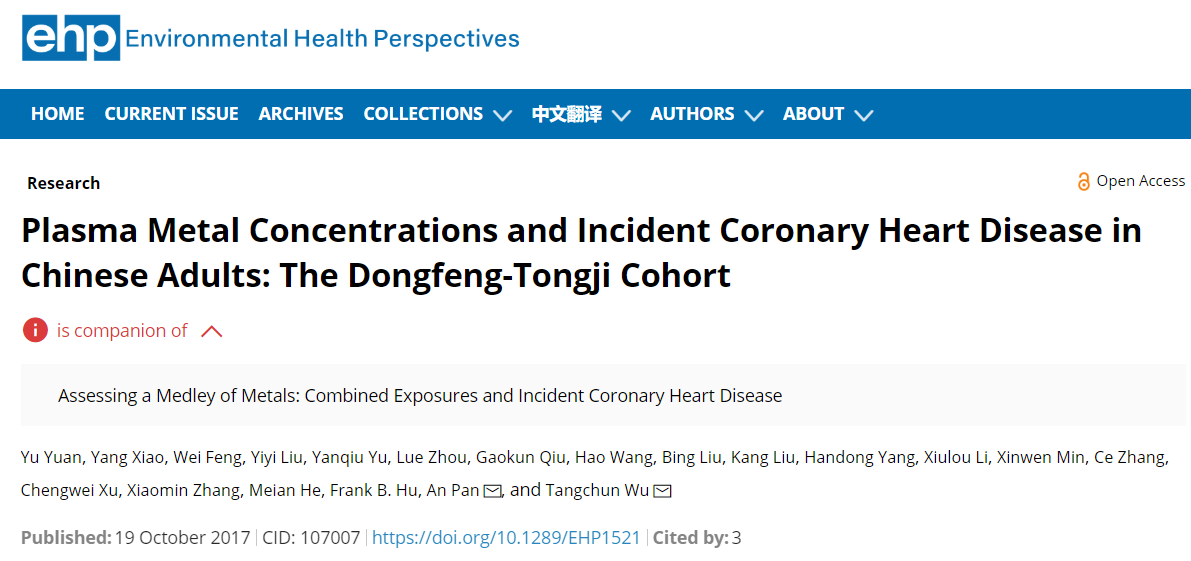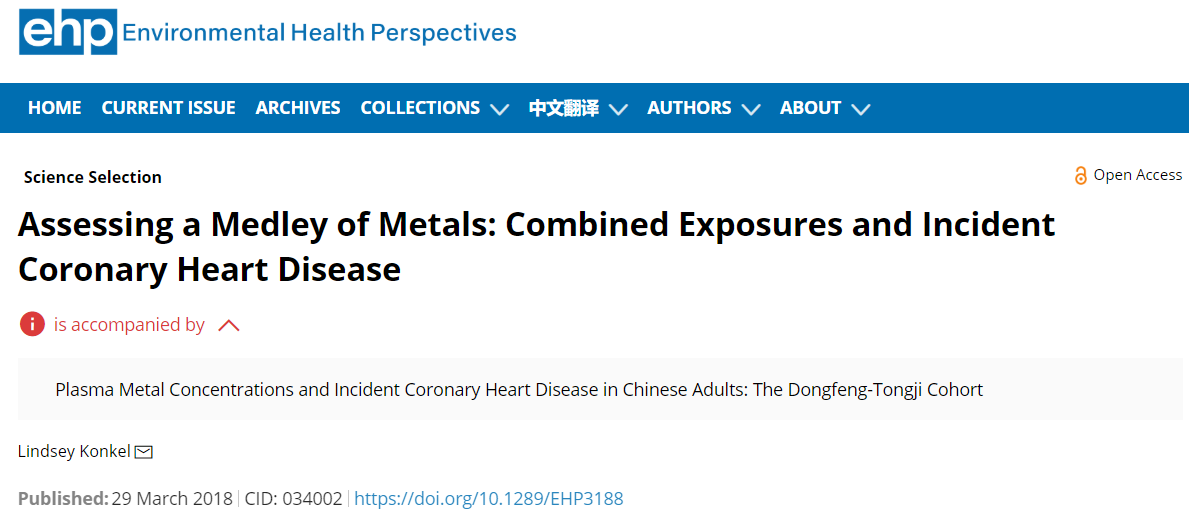Wuhan, China — On March 29th, 2018, Environmental Health Perspectives (the top journal of environmental epidemiology, IF=9.8) published a special news report in the Science Selection titled "Assessing a Medley of Metals: Combined Exposures and Incident Coronary Heart diseases ". In the report, several expertise provided encouraging comments on the study of “Plasma Metal Concentrations and Incident Coronary Heart Disease in Chinese Adults: The Dongfeng-Tongji Cohort”, which was also published on Environmental Health Perspectives. Prof. Wu Tangchun and Prof. Pan An in Huazhong University of Science and Technology are co-corresponding authors of the manuscript, while Dr. Yuan Yu is the first author. The study was sponsored by the Foundation of National Key Program of Research and Development, and the Natural National Scientific Foundation of China.
With the rapid development of society, including urbanization and population aging, the chronic non-communicable disease has become a major threat to global health. Among all the non-communicable disease, cardiovascular disease is the leading cause of death and has contributed to increasing disease burden globally. It has been well-recognized that both environmental factors (chemical exposure, lifestyle habits, dietary habits, etc.) and genetic predisposition would contribute to the development of coronary heart disease. Metals’ mixture is one of the most prevalent environment exposures worldwide and coexisted in the environment. In the daily life, exposures to multiple metals occur simultaneously through air, water, food, and consumer products, and contributes to a variety of health outcomes. Although the co-exposure of multiple metals is a real-world scenario, it is lack of studies investigating the association between multiple metals exposure and incident coronary heart disease.
The nested case-control study is based on the prospective Dongfeng-Tongji cohort, which collected baseline information during September 2008–June 2010, and invited all participants to a follow-up examination in 2013. A total of 1,621 incident CHD cases and 1,621 controls free of major cardiovascular disease at baseline and follow-up visits were matched on age (± 5 years) and sex. The researchers measured baseline fasting plasma concentrations of 23 metals and used conditional logistic regression models to estimate odds ratios (ORs) of CHD for metal concentrations categorized according to quartiles in controls. Five metals (titanium, arsenic, selenium, aluminum, and barium) were significantly associated with CHD based on trend tests from single metal multivariable models adjusted for established cardiovascular risk factors. When all five were included in the same model, adjusted ORs for barium and aluminum were close to the null, whereas associations with titanium, arsenic, and selenium were similar to estimates from single-metal models, and ORs comparing extreme quartiles were 1.32 (95% CI: 1.03, 1.69; p-trend = 0:04), 1.78 (95% CI: 1.29, 2.46; p-trend = 0:001), and 0.67 (95% CI: 0.52, 0.85; p-trend = 0:001), respectively. Moreover, the study also provide evidence that higher level of selenium would attenuate the positive association of arsenic, titanium with coronary heart disease. In addition, the researchers further explore whether plasma biomarker is a suitable internal biomarker through metal correlation study and metal variability study. The studies suggested a moderate-to-high correlation of plasma levels of arsenic and selenium to urine/whole blood levels, and a moderate correlation of plasma levels of titanium to urine levels. “This provide some confidence [in the use of] plasma concentrations as internal biomarkers to characterize exposures to those metals,” said coauthor Prof. Pan.
“The correlation between titanium and heart disease is really novel and needs to be further investigated,” said Prof Chen Yu, a chronic disease epidemiologist at New York University School of Medicine who was not involved with the study. Chen also pointed to the Strong Heart Study—a cohort of American Indian men and women—as another population in which levels of arsenic were similarly low yet still associated with CHD. “It is important to see consistent associations across populations with different background risk factors,” Chen said. “This gives us some confidence that the association is not due to confounding risk factors.” The study corroborates previous research on the link between arsenic exposure and cardiovascular disease. “It is part of a building case that low-to-moderate levels of arsenic exposure are associated with incident cardiovascular disease,” said Prof. Katherine Moon, an environmental epidemiologist at the Johns Hopkins Bloomberg School of Public Health. Future studies, she suggested, could look at measures of longer-term arsenic exposure, such as toenail clippings.
Chinese News Link: http://gwxy.tjmu.edu.cn/info/1067/2210.htm
Link of EHP news report: Assessing a Medley of Metals: Combined Exposures and Incident Coronary Heart Disease. https://ehp.niehs.nih.gov/ehp3188/
Link of original study: Yuan Y, Xiao Y, Feng W, Liu Y, Yu Y, Zhou L, Qiu G, Wang H, Liu B, Liu K, Yang H, Li X, Min X, Zhang C, Xu C, Zhang X, He M, Hu FB, Pan A, Wu T. Plasma Metal Concentrations and Incident Coronary Heart Disease in Chinese Adults: The Dongfeng-Tongji Cohort. Environ Health Perspect, 2017,125(10):107007. https://ehp.niehs.nih.gov/ehp1521/



